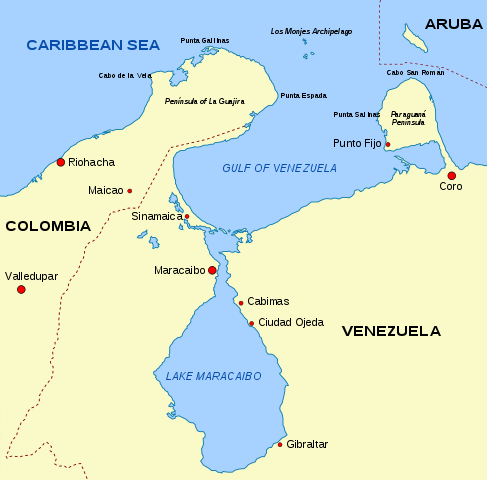Gulf of Venezuela: Guajira Peninsula (South America)
The Gulf of Venezuela is an inlet of the Caribbean Sea bounded by Venezuela and Colombia. It is a shipping route for the petroleum-producing Maracaibo region. The Guajira Peninsula is located in northeastern Colombia and northwestern Venezuela.
Gulf of Venezuela
The Gulf of Venezuela is an inlet of the Caribbean Sea bounded by Venezuela and Colombia. The Gulf is located on the north coast of South America, between the Paraguaná Peninsula of Falcón State to the east in Venezuela and the Guajira Peninsula in Colombia to the west.
The Gulf is surrounded by lowlands with little or no cultivation. It is a shipping route for the petroleum-producing Lake Maracaibo region. It is connected south to Lake Maracaibo through an artificial navigation canal.
Despite decades-long negotiations conducted by a bilateral commission, Colombia and Venezuela have had a longstanding dispute over control of the Gulf that has not been resolved.

Map showing the Guajira Peninsula, the Gulf of Venezuela and Lake Maracaibo.
Guajira Peninsula
The Guajira Peninsula is located in northern Colombia and northwestern Venezuela, where it is known as the La Guajira Peninsula. It is the northernmost peninsula in South America and has an area of 25,000 sq km (9,700 sq mi).
It is bounded by the Caribbean Sea to the north and west, the Gulf of Venezuela to the southeast, and the Sierra Nevada de Santa Marta and the Sierra de Perijá to the south.
Much of the peninsula lies in northeastern Colombia; the rest is in northwestern Venezuela, where it is known as the La Guajira Peninsula.
The region receives the flow of trade winds from the northern hemisphere. As a result, the northeastern coast of Venezuela and the Antilles have Guajira-Barranquilla xeric scrub.
The trade winds cause a resurgence of the deep coastal waters and make the sea richer for living species on the peninsula's western side.
The northeastern flank of the Sierra Nevada de Santa Marta mountain range acts as a barrier that generates abundant rainfall in its steppes, forming the headwaters of the Ranchería River, the only major river in the area.
Climate and vegetation vary from south to north, presenting hyper-humid jungle weather in the southern part (with 3000 mm or 120 in rainfall yearly) to the desertic areas in the north (300 mm or 12 in a year).
The peninsula is inhabited mainly by members of the native tribe of the Wayuu, who use the plains to raise cattle, sheep, goats and horses. The descendants of Spanish colonists settled in the southeastern part of the peninsula (sometimes referred to as the Padilla Province).
This area has more fertile land due to the proximity to other river basins, such as the Cesar River basin. As a result, it has been developed for large plantations of cotton and sorghum as well as for cattle ranching.
